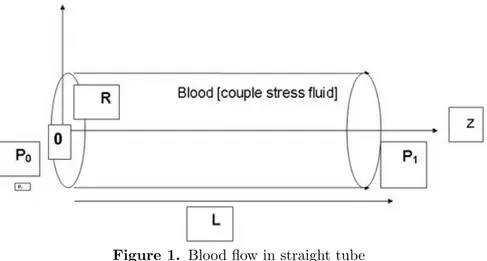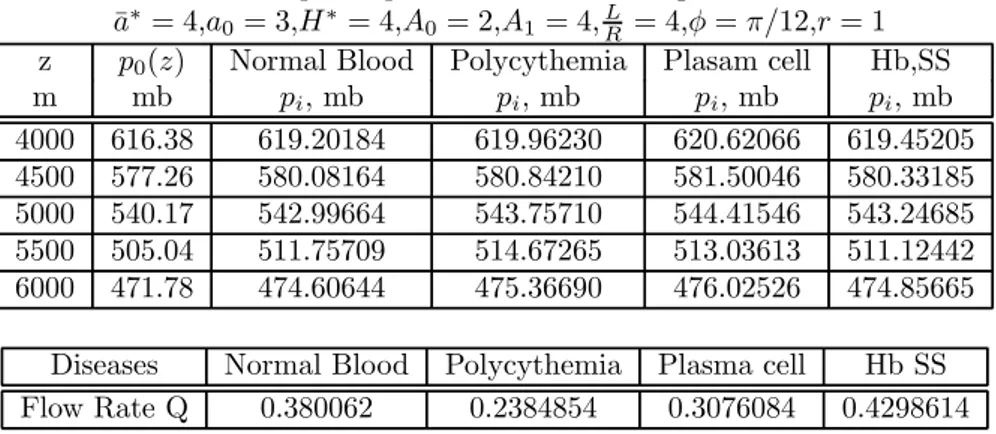Selçuk J. Appl. Math. Selçuk Journal of Vol. 13. No. 1. pp. 35-40, 2012 Applied Mathematics
Mathematical Model of the Impact of Pressure Drop on Human Body Ahmad Reza Haghighi
Department of Mathematics, Urmia University of Technology,Urmia, Iran e-mail: ah.haghighi@ gm ail.com
Received Date: July 29, 2011 Accepted Date: September 14, 2011
Abstract. Mathematical model for the impact of pressure drop on the human body has been investigated in the present studies. The studies has been aimed at personnel (army and mountaineer) who would be prone for higher altitude ef-fect on the body and to suggest them appropriate measures (as a precautionary or advisory purpose) who either will be getting inducted onto higher altitudes venturing onto higher peaks. The model accounts for heights of altitudes rang-ing from 4000-6000 meters and accountrang-ing for all the possible cardiovascular diseases.
Key words: Physiological fluid dynamics; Heart Attack; Effect of Low pres-sure; Higher altitude.
2000 Mathematics Subject Classification: 92B05, 92C35, 76Z05. 1. Introduction
In the present studies physiological aspect of the blood flow has been mod-eled with a view to estimate the physiological flow parameters such as pressure, against adverse conditions. The study is basically aims at as an advisory and precautionary mode. Efforts have been made to compare the results with prac-tical situations available in the literature with respect to myocardial infarction [heart attack]. Blood flow modeling has paved the way for understanding the intricacy of the fluid flow pattern in the human body[1,2].The importance of blood flow in Cardiovascular system has been highlighted by Young[3]. Later the models have been refined by accounting it for pulsatile aspect [4] and the ef-fects of blood cells [5-6] by using micro-continuum theories [7-9].Effects of body acceleration and magnetism have also been studied on the blood flows [10-12]. In the present model, blood is assumed to be represented by a couple stress fluids [7] and the model has been developed for the straight tube [Figure1].
2. Analysis
It is assumed that the flow is steady and laminar and turbulence effects in the body are neglected
(1) η∇4u − μ∇2u + σB02u = −∂p ∂z+ ρG
Where u(r) is the velocity in the axial direction, ρ and μ are the density and vis-cosity of blood, η is the couple stress parameter, σ is the electrical conductivity, B0 is the external magnetic field and r is the radial coordinate.
(2) ∇2=1 r 1 ∂r(r ∂ ∂r)
The flow geometry of blood flow has been shown in figure 1.
Figure 1. Blood flow in straight tube
The Pressure gradient and body acceleration are assumed to be of the form [10]
(3) −∂p
∂z = A0+ A1 , G = a0cos(φ)
Where A0the steady-state part of pressure gradient, A1is the amplitude of the
oscillatory part, a0is the amplitude of body acceleration,φ the phase difference,z
is the axial distance. Flow variables have been normalized by using flowing relations: (4) u∗= u ωR, r ∗= r R, A ∗ 0= R μωA0, A ∗ 1= R μωA1, a ∗ 0= ρR μωa0, Z ast= z R. Where ω = 2πf and f is heart pulse frequency. Equation (1) simplifies to (5) ∇4u − ¯a2∇2u = ¯a2A0+ ¯a2A1+ ¯a2a0cos(φ) − ¯a2H2u
Where ¯a2 = ¯a∗2 μ
μ1 , couple stress parameter,H = H
∗qμ
μ1 is the Hartmann
number ,and R is the radius pipe.
(6) ¯a∗2 =R 2μ 1 η , H ∗= B 0R rσ μ1
Shakera and Rathod [10] have analyzed the model for velocity computation for the straight tube and this expression for velocity has been taken for further investigations in the present studies with appropriate changes for the present analysis if straight tube .
(7) u(r∗, t) = Σ∞n=1J0(r∗λn)¯a 2 λnJ(λn) [A0+ A1+ a0cos φ] [λ4n+ ¯a2(λ2 n+ H2)]
And J0 and J1 are the Bessel functions of order zero and one respectively and
λn are the boots of equation J0(r) = 0. Uses of transform techniques [13] have
been made use in solving equation(5). 3. Flow Rate (8) Q = 2π Z 1 0 ru(r)dr , Q = Σ∞n=1¯a 2 λ4n [A0+ A1+ a0cos φ] [λ4n+ ¯a2(λ2 n+ H2)] 4. Resistance to Flow
Resistance to flow λ has been computed by using following relation
(9) λ =p1− p0
Q λ
∗= λ( p0
λ1ω
) Wherep0 is the pressure used for normalizing p.
5. Computation of Pressure with altitude
The equation which computes atmospheric pressure with altitude (as per Inter-national standard) is given by[14]
(10) p0(z) = 1013 × b(1 − 220558 × 10−6× z)525611c
Here 1013.25 is the pressure at sea level in mil/bar, z is the altitude in meters. Knowing p0(z) and the relation for resistance to flow, the pressure variation on
the human body have been computed by the following method. We have
(11) λi =
pi− p0
The units for pi pressure [equation (12)] are dynes/cm2. In order make Qλi has
same units that of pi,λi and Q have been converted to the following expression
(12) λ = λ¯ iλ0 , ¯Q = QQ0
Here λ0and Q0 are taken in the form [5]
(13) λo= μ1L πR4 0 and Q0= πLR2 0 t
The values of μ1[viscosity of plasma] is taken to be 1.2 × 10−2 Poise, L = 4cm,
R = 1cm. The value of λ0 = 0.01527dynes/cm3 and Q0 = 12.571cm3/sec has
been obtained and incorporated in the computation of pi. It is assumed that, the
atmospheric pressure variation has been accounted in the initial development of the model.
6. Results and Discussion
For the computation of resistance to flow λifor different diseases, data for μ and
μ1are required and this data has been taken from [5] and shown in Table 1.The values of p (for pi at r∗) Normal blood and for different diseases has been
com-puted and tabulated in Table [2-3]. Also selected variations of pi with various flow parameters have been shown in figure [2]. Results indicate that, values for pressure at higher altitudes, in the blood diseases; Polycythemia, Pleasma cell Dyscrasis values are higher to Normal blood.[Table 2-3]. The analysis confirms that, pressure decreases with the increases in the altitude. Also it is observed that, pressure values decreases with the increases in H∗[magnetic effects] (Fig-ure 2).
Table 1. Computed pressure for various higher altitudes.
Numbers Deceases μ, cP μ1, cP
1 Normal Blood 3.81 1.2
2 Polycythemia 6.75 1.2
3 Plasma cell Dyscrasis 4.99 1.2
4 Hb SS 3.29 1.2
Table 2. computed pressure for various higher altitudes. ¯
a∗ = 4,a0= 3,H∗= 2,A0= 2,A1= 4,L
R = 4,φ = π/12,r = 1
z p0(z) Normal Blood Polycythemia Plasam cell Hb,SS
m mb pi, mb pi, mb pi, mb pi, mb 4000 616.38 623.09419 626.00975 624.37323 622.46152 4500 577.26 583.97399 586.88955 585.25303 583.34132 5000 540.17 546.88899 549.80455 548.16803 546.25632 5500 505.04 511.75709 514.67265 513.03613 511.12442 6000 471.78 478.49879 481.41435 479.77783 477.86612
Diseases Normal Blood Polycythemia Plasma cell Hb SS Flow Rate Q 1.079490 0.7452251 0.9147911 1.171579
Table 3. computed pressure for various higher altitudes. ¯
a∗ = 4,a
0= 3,H∗= 4,A0= 2,A1= 4,LR = 4,φ = π/12,r = 1
z p0(z) Normal Blood Polycythemia Plasam cell Hb,SS
m mb pi, mb pi, mb pi, mb pi, mb 4000 616.38 619.20184 619.96230 620.62066 619.45205 4500 577.26 580.08164 580.84210 581.50046 580.33185 5000 540.17 542.99664 543.75710 544.41546 543.24685 5500 505.04 511.75709 514.67265 513.03613 511.12442 6000 471.78 474.60644 475.36690 476.02526 474.85665
Diseases Normal Blood Polycythemia Plasma cell Hb SS Flow Rate Q 0.380062 0.2384854 0.3076084 0.4298614
Figure 2. a¯∗= 4, a
0= 3, A0= 2, A1= 4, LR = 4, φ = π/12, r = 1
7. Conclusions
Mathematical model for blood flow has been developed in the present model with a view to correlate the finding with its impact on higher altitude [for the benefit of mountaineer or service, personnel getting inducted onto higher altitudes].This has been done with a view to analyze its enhanced effect on the higher altitude for those who will be or already prone for Cardiovascular problems [disease related to myocardial infraction].The diseases chosen for the
present computation propose are Polycythemia,Pleasma cell dyscrasis and for Hb SS(sickle cell Anemia).The data has been collected from earlier published results [6, 11]. Resistance to flow values has been made use of for computing the pressure computations at higher altitudes.The computed pressures for different altitudes have been shown in Table 2 and 3.The results indicate that, pressure drops with altitude and its effects enhances(lowering of pressure values) with the diseased case. lowering value of pressure in diseases case signifies that the person prone for heart disease can perform to some extent better in lower altitudes but certainly not advisable in higher altitudes. Such measures are useful for the doctors and the service personal for inducting the staff on the higher altitudes. The findings of the present model are required to be tested for its actual utility point of view.Once the results are confirmed the model can be used for other related diseases.
References
1. Fung,Y.C.(1984):(Bio-mechanics, Springer-Verlag). 2. Fung,Y.C.(1986): (Bio-dynamics, Springer-Verlag).
3. Young,D.F.(1979): Fluid mechanics of arterial stenoses,J.biomech.Eng,101-125. 4. Srivastava, L.M. and Srivastava, V.P (1984): Peristaltic transport of blood Casson model II, J.Biomechanice,17,821-829.
5. Pralhad, R. N. and Schultz, D.H. (2004): Modeling of arterial stenosis and its applications to blood diseases, Mathematical Bio-sciences, 203-220.
6. Haghighi, A.R. and Pralhad, R.N. (2009): Mathematical modeling of blood flows under the effects of body forces and magnetism on human Body, Int. J. Biomedical Engineering and Technology, Vol.2, no.4,295-302.
7. Stokes, V. K. (1966): Couple stresses in fluids, Phys. Fluids,9, 1709-1715. 8. Cowin, S.C. (1966): The theory of polar fluids, Adv.Appl.Mech.14, 169-180. 9. Eringen, A.C. (1966): The theory of micro-polar fluid,J.Math.Mech., 276-287. 10. Shakera, T. (2005):Blood flow through narrow tubes with periodic body acceler-ation in presence of magnetic field and its applicacceler-ation to cardiovascular diseases,PhD thesis,Gulbarga University, India.
11. Haghighi, A.R. and Pralhad, R.N. (2008): Effects of Body Accelerations and Synchronized Pressure Distributions on the Human Body and Its Aggravations on Pa-tients with Blood Diseases, Indian Journal of Mathematics and Mathematical Sciences, Vol.4, no.2. 63-73.
12. Mandal, P.K. (2005):An unsteady analysis of non-Newtonian blood flow through tapered arteries with a stenosis, International Journal of Non-Linear Mechanics ,151-164.
13. Sneddon, N. (1980): Special function of mathematical physics and chemistry, (Longman).


